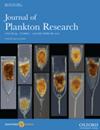小即是美:小型桡足动物在南本格拉上升流系统的碳收支中的重要作用
IF 1.9
3区 环境科学与生态学
Q2 MARINE & FRESHWATER BIOLOGY
引用次数: 0
摘要
小型桡足类动物在海洋食物网和生物地球化学通量中发挥着重要作用,但在许多研究中被忽视。这是第一个在本格拉南部上升流系统沿跨大陆架样带测定小型(1毫米)、中型(1 - 1.5毫米)和大型(2毫米)桡足类的生物量、碳消耗和消化率的研究。鱿鱼类平均占桡足类总丰度的55±19%,占桡足类总生物量的82±13%。在大多数近岸站中,小角鲨科(114 ~ 119 mg C m−2 d−1)、小角鲨科/副角鲨科(87 ~ 263 mg C m−2 d−1)和大角鲨科(47 ~ 193 mg C m−2 d−1)是主要的消耗者。绿藻的中小型桡足动物阶段也很重要,特别是向大陆斜坡方向。近海站点的主要食虫种为狐尾藻科/副狐尾藻科、狐尾藻科、灰尾藻科、灰尾藻科、灰尾藻科、灰尾藻科、灰尾藻科和绿尾藻科。因此,通常中小型桡足类在总桡足类摄食和摄食中占主导地位,强调小型桡足类的代表性不足将导致对浮游动物群落功能的严重低估和误解,最终导致生物地球化学模型的不充分。本文章由计算机程序翻译,如有差异,请以英文原文为准。
Small is beautiful: the important role of small copepods in carbon budgets of the southern Benguela upwelling system
Small copepod genera play an important role in marine food webs and biogeochemical fluxes but have been neglected in many studies. This is the first study determining biomass, carbon consumption and egestion rates of small- (<1 mm prosome length, PL), medium- (1–1.5 mm PL) and large-sized (>2 mm PL) copepods along a cross-shelf transect in the southern Benguela upwelling system. Calanoids contributed on average 55 ± 19% to total copepod abundance and 82 ± 13% to total copepod biomass. Small-sized Oithona spp. (114–119 mg C m−2 d−1) and Clausocalanidae/Paracalanidae (87–263 mg C m−2 d−1) as well as large-sized Calanoides natalis (47–193 mg C m−2 d−1) were the dominant consumers at the most inshore stations. Small- and medium-sized copepodite stages of Metridia lucens were also important, especially towards the continental slope. At offshore stations, Clausocalanidae/Paracalanidae, Oithona spp., Pleuromamma spp., Calanus agulhensis, Acartia spp., C. natalis and M. lucens were dominant consumers. Hence, usually small- and medium-sized copepods dominated total copepod ingestion and egestion, emphasizing that inadequate representation of small copepods will lead to significant underestimations and misinterpretations of the functioning of zooplankton communities and finally to inadequate biogeochemical models.
求助全文
通过发布文献求助,成功后即可免费获取论文全文。
去求助
来源期刊

Journal of Plankton Research
生物-海洋学
CiteScore
3.50
自引率
9.50%
发文量
65
审稿时长
1 months
期刊介绍:
Journal of Plankton Research publishes innovative papers that significantly advance the field of plankton research, and in particular, our understanding of plankton dynamics.
 求助内容:
求助内容: 应助结果提醒方式:
应助结果提醒方式:


